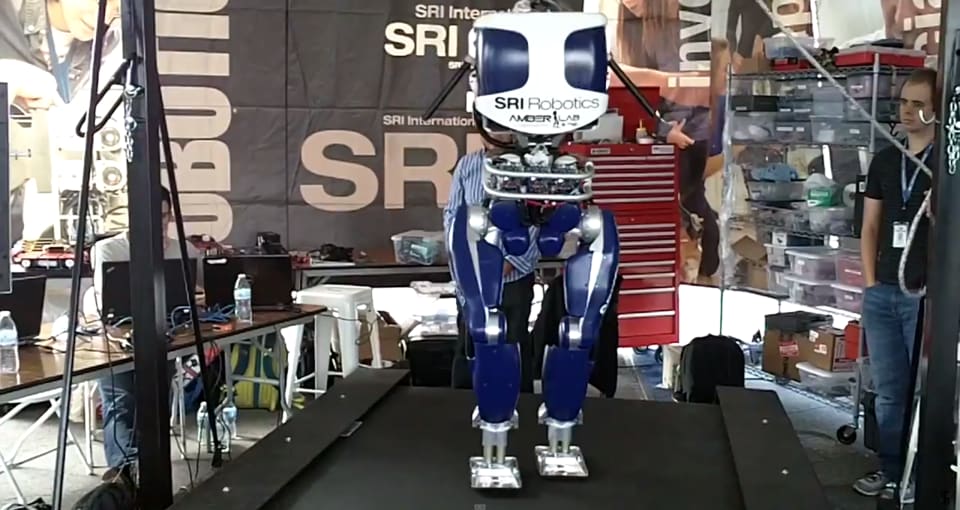この超高効率ロボットはヒトのように歩行する
This ultra-efficient robot walks just like people do
You don't have to worry about robots rising up against humanity anytime soon -- the bipedal ones, at least. When they aren't constantly falling down, two-legged robots are running down their power supplies due to inefficient gaits and wasted motion. During a recent DARPA competition, teams from Sandia National Labs and SRI International squared off to see whose robot could walk the furthest. SRI's robot, dubbed the "DURUS," won out by walking 2.05 kilometers in just over two and a half hours while using just 350 watts of power. For those of us who aren't electrical engineers, that's a really impressive feat. In fact, the DURUS uses up to 30 times less power than the ATLAS robot employed in the DARPA challenge.
ロボットが近い将来、人間に対抗して「立ち上がる」という心配をする必要はありません。少なくとも二足歩行のは。 彼らが常に落下していない時、二足歩行のロボットは、非効率な歩き方と無駄な動きによって、電力を使用しています。 先日の DARPA のコンペティションの間、Sandia国立研究所とSRIインターナショナルからのチームが、そのどちらのロボットが最も長い距離を歩けるかを見るため対峙した。 「DURUS(ラテン語。英語ではTOUGHの意味)」と呼ばれるSRIのロボットが、2.05キロメートルを歩いて勝負に勝った。 2.5時間以上かかって、350ワットの力を使用した。 電気エンジニアでないヒトのために言うと、これは本当に印象的な偉業です。 実際、DURUSは、DARPAチャレンジで採用された ATLAS よりも、30倍少ない(30分の1?)電力しか使用していません。
- anytime soon - 近いうちに
- gaits - 足取り、足並み、歩き方。
- furthest - 最も遠く
- squared off - 戦う構えを見せる
- feat - 偉業
In standardized terms, the DURUS offers a cost of transport -- how the rate of energy efficient in moving from point A to point B -- of 1.5. It's magnitudes higher than a human's cost of transport of .2 or the DARPA cheetah-bot's .5 rating but it's a massive improvement over the ATLAS whose cost of transport is around 20. Sandia labs researchers accomplished this impressive feat by systematically improving every mechanical component's energy efficiency -- from the motors and actuators to the wiring itself. They even improved the robot's gait to make it more fluid like a human's, rather wobbling back and forth like a wind-up Godzilla toy. With some minor tuning, the Sandia team hopes to get the DURUS' cost of transport under 1, which could give it a range of up to 10km using its existing 2.2 kWh lithium-polymer battery.
一般的に言って、DURUSは1.5の輸送コスト ― A地点からB地点へ移動するときの、エネルギー効率の割合がどれくらいか ― を提供します。 それは、人間の輸送コストである 0.2 や、 DARPAの cheetah-bot の 0.5 を大きく上回っています。しかし、これは、輸送コストが20ぐらいの ATLAS を超える、素晴らしい改善です。 Sadia研究所の研究者は、この印象的な偉業を、機械的構成要素(モーターやアクチュエーターから配線まで)のエネルギー効率を体系的に改善することで、達成しました。 彼らは、ロボットの歩き方も、ゼンマイのゴジラのおもちゃのように、揺れて戻って進むようなものから、人間の流れるような足取りに改善しました。 いくつかの小さなチューニングとして、Sandiaのチームは、DURUS の輸送コストを1未満にしたいと思っています。 これは、すでに存在している2.2キロワット時のリチウムポリマーバッテリーを使用して10キロメートルまでの範囲を与えられる値です。
- wobbling - ブレる
- systematically - 体系的
- component - 構成要素
元記事は以下からどうぞ。

